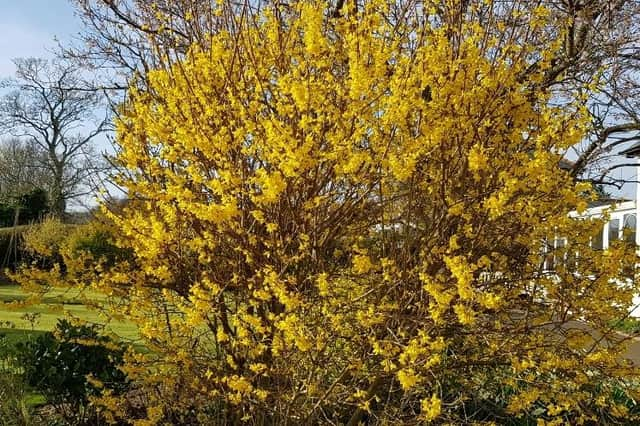Gardening: The speed with which spring arrived took my breath away | Brian Kidd


I have never felt old before and it now takes some time to become a rapid mover!
Things changed so rapidly, everything looked so dull and then suddenly it all came back to life again. I have never before experienced such a transformation.
Advertisement
Hide AdAdvertisement
Hide AdWhat a brilliant year for camellias. The first one to come into bloom was camellia simplex Alba, during the first week in January and it is still abundant. On windy days you could be forgiven for thinking a wedding had taken place.
It will be time to start some shrub pruning soon. All spring-flowering shrubs are pruned as soon as the flowers fade. For example forsythia can be pruned really hard.
It’s a bit daunting but here’s a little tip which will make the job easier.
Treat yourself to a pair of long-handled secateurs. Now pull out a large branch towards you and look towards the base of the shrub. You will see one or more straight shoots with no side shoots.
Advertisement
Hide AdAdvertisement
Hide AdPrune the shrub right down to where the long straight shoots are situated, leaving the straight ones of course.
Pull out the next branch and prune this in the same way and continue all around the shrub, it’s easy and quick with a pair of long-handled secateurs.
On the ground there will now be large pieces of forsythia. These can be bundled up and taken to the recycling centre when they reopen, or kept to support herbaceous plants or peas.
Do you have a mimosa? This needs to be pruned right now or as soon as the flowers die off. Here’s a tip: Look at where the buds are swelling and instead of pruning back to an outward pointing bud, prune back to one which is growing inwards. The top bud grows faster than the others and if you follow this advice the branches will grow inwards and the tree will be more compact and resilient to the wind.
What about pruning precious plants such as camellia?
Advertisement
Hide AdAdvertisement
Hide AdThese can be pruned as hard as you wish provided the pruning is done as soon as the flowers fall.
They are evergreen and when pruned at the correct time all pruning cuts are hidden by new growth within a month.
All that is needed is to prune to a good shape and the good news is that all the new growth will come into bloom next winter and into spring. If a camellia is becoming too large, it may be a good idea to remove some of the lower branches completely.
This is done using a pruning saw. Each branch is cut off right back to the main trunk. If this idea appeals to you, you can even turn a camellia shrub into a small tree. Or what about a camellia the same size as a standard rose?
Advertisement
Hide AdAdvertisement
Hide AdAh, but if I do it, will it still flower? Yes, as long as you do the pruning as soon as the flowers fade.
Plums and all stone fruits, yes figs too, need to be pruned only if it is essential. Pruning must only be
done when the plants are in full leaf but it must before St Swithin’s Day (July 15, as you ask).
A much better way to ensure bumper crops is to tie the branches so that the tips are facing the ground. This is done with strong twine.
Advertisement
Hide AdAdvertisement
Hide AdCherries grown on a trellis crop exceptionally well if all the new shoots are tied down in half circles while the shoots are still flexible and the shape of the cherry tree looks great and professionally maintained. When the flowers appear, the whole thing looks fabulous.
Peaches and nectarines are pruned a few days before St Swithin’s day. The pruning is very easy to do with a pair of scissors. Simply cut all the new shoots back to five pairs of leaves,
Next year’s fruit will be on the wood which was left unpruned and the fruits are always on the growth that grew the previous year.
THIS WEEK’S TOP TIP
A handy sprayer containing Roundup weedkiller is very useful for spraying weeds in cracks in paths at this time of year. Roundup kills all plants, so mind it doesn’t drift on to cultivated plants.
Comment Guidelines
National World encourages reader discussion on our stories. User feedback, insights and back-and-forth exchanges add a rich layer of context to reporting. Please review our Community Guidelines before commenting.